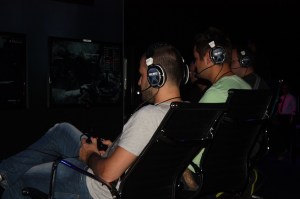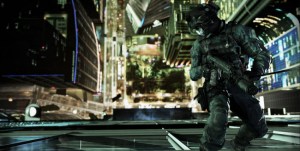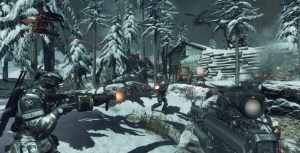Among the 10 million people who play Call of Duty multiplayer every day, you can bet there are a lot of women. Overall, women represent 45 percent of players. But in the decade-long history of the blockbuster video game, you couldn’t play as a woman. Now, in the multiplayer version of the upcoming Call of Duty: Ghosts, you’ll finally be able to choose a female character.
Mark Rubin, the executive producer at Infinity Ward, the developer of the game, explained why that’s the case in an interview with GamesBeat. Adding a gender option was one of many design decisions that Rubin explained in our talk at the Call of Duty multiplayer event this week in downtown Los Angeles. Here’s an edited transcript of our interview.
GamesBeat: Could you start from the top a little and describe how you approached the multiplayer? What did you want to do that was different from what you’ve done before?
Mark Rubin: For us, the whole thing started with … everything. It was going to be a platform transition. We needed a new engine. Then we were going to need a new engine for the current generation as well. We finished the Modern Warfare story arc, so now single-player was going to take a new arc. All this stuff led to the idea that we were pushing for as much new as we possibly could.
This is the biggest change to multiplayer we’ve had since the first Modern Warfare. A lot of it comes from tech. For instance, character customization couldn’t have happened without a new engine. We had to completely revamp the way the engine handles memory, with over 20,000 different combinations to handle. That led us to more customization, not just for looks, but for the way you do your loadouts, revamping the system getting people to have a fresh look on what they’re playing.
The way perks work became totally different. Progression is completely different. You don’t level to unlock something. You level to unlock squad points which you can use to unlock stuff. It’s not like, “I have to get to level 42 to unlock X rifle.” Let’s say it’s a six-point weapon. Once I earn six squad points, I can go unlock it. I don’t have to wait.
GamesBeat: That seems like something people really wanted in past games. They hated having to wait for it.
Rubin: Yeah. This came from a lot of player feedback. They’ve been through the leveling process so many times every year. A lot of people just play Call of Duty. That’s all they ever play, every day, and they play it for the entire year until the next one comes out. Like Eric [Hirshberg, the chief executive officer of Activision Publishing] said, there will be 10 million people playing the game today. That’s how many months after it launched? So we had a lot of people asking, “Can we please not have to grind levels? Can you do something different with progression?” We thought, “Yeah, let’s tackle that. Let’s do something different and make people feel like they have more control.”
GamesBeat: Are you able to predict, at this point, what the fans are going to be talking about as far as multiplayer?
Rubin: A lot of the questions that have come up during interviews have been about the dog. Everyone loves the dog. I’m hoping that people latch on to character customization. I think what’s going to happen is that, over the next week or so, they’ll dissect all the videos. Someone’s going to frame-by-frame through the multiplayer video and find every little thing in there. Female characters are going to be a huge hit, I think.
Someone asked me about that, by the way. For me, adding women wasn’t an attempt to expand our user base so much as it was an acknowledgement of a user base that was already there. We already have a huge variety of people playing our game. When it came to character customization, it was obvious that we should make sure to be as inclusive as possible. I like it because I think it acknowledges a group of people who already play, who have a great time playing Call of Duty. I was very happy about announcing that.
GamesBeat: In Black Ops II, you had the points system come in, where you could spend a certain number of points on stuff.
Rubin: Yeah. What that allows you to do is remove things to get extra points to spend. We’ve done something similar. Your weapons and equipment all have a point value, and so do your perks. You have eight perk slots, normally, and then a primary weapon, a secondary weapon, and two pieces of equipment.
GamesBeat: That’s a lot of perks.
Rubin: It is a lot of perks. Putting together your perk loadouts becomes part of your strategy, and you can do this right off the bat. Then you can remove your secondary or remove your equipment and get up to 11 perk slots.
Again, keeping that theme of customization going, we wanted to play around with game modes that offered a variety of gameplay – fast game modes, slower game modes. Small maps, the kind that people love in Call of Duty, and larger, organic maps that aren’t like anything you might have seen in Call of Duty, that have a different play style.
The whole Squads mode fed out of what we were doing with create-a-soldier and create-a-squad – modes that allow you to experience multiplayer in ways that you weren’t expecting. It’ll feel like multiplayer, and the AI has been written so that it feels like a real player. The AI will camp in corners. They’ll do a lot of things that you hate other players for doing. It makes you feel like you’re playing against people, but you get to control the experience.
We’re also adding things that don’t have any relationship, like me and my squad versus you and your squad while you’re offline. You’re at work, I’m at home playing, and I can challenge your squad. What will happen is that from your 10 squad members, you’ll pick six to populate a map, plus a game mode. Then I’ll find you on my friends list and challenge them.
A whole new strategy comes out of this where you decide the loadouts for your squad. For instance, if you decided to put your squad on a small map and loaded everyone up with sniper rifles, they probably aren’t going to do very well. You want to pay attention to the equipment, the kill streaks, everything your squad can use, and strategize the map and the mode together. Then I’ll come in with my squad and try to play against your squad and see how I do. We’ll both earn XP for multiplayer while we do that, even though you’re offline.
GamesBeat: Where do you come up with these ideas?
Rubin: Lots of weird hours in hot offices. [Laughs] It was just the idea of being able to asynchronously play against each other and have our squads do stuff while we weren’t playing.
GamesBeat: How independently do you guys operate from Treyarch? Do you not necessarily look at their advances each year?
Rubin: What it comes down to is, we’re in different cycles. Right now we’re in crunch mode, getting the game finished. We’re doing press and PR. They’re in the preproduction phase. We’re so out of sync from a production standpoint that there’s not a lot of opportunity for crossover. We’re going to ease off this game into DLC and move on to making the next game, and then they’ll be in their crunch. It just never quite allows us to work together like that.
GamesBeat: One of the things I think we saw last year was a greater accessibility on the Black Ops II side as far as multiplayer philosophies. You had the larger reticle, the designs around it. That big pink X would show up, and you would just fire, right? The shock charges, too — pro players really hated those.
Rubin: Both teams try to give to both sides. We have such a huge community that we have every type of player you could imagine. We have every type of casual player, non-casual player, hardcore player, e-sports player. We have to try to cater to everybody, which is a huge challenge. But the two studios take different routes to get to that. They’re different, and that’s a good thing. It adds a little variety to what Call of Duty has to offer.
Unless you’re a pro player, you may not notice this, but the movement is slightly slower or faster on one or the other. The health is slightly lower or higher. The pro guys notice it right away. They’ll play either. They like both. But there is definitely a philosophy difference between the two studios.
GamesBeat: These new movement features, like the contextual lean and the mantling and the knee slide. It seems like the pros would really appreciate those. They’re fancier ways to avoid somebody.
Rubin: They do add some more to your arsenal for movement through the world. It’s going to be helpful for the casual guys as well, though, because we’ve made it easy to do. It’s not like you need massive skill to be able to do this. Leaning is simple. You go up to a corner and you aim down the sights. There’s no special button. It’ll just lean out for you.
GamesBeat: This is more a development question. I just wonder how you get these things done. The resource demands seem to be multiplying. You have the PC, Xbox 360, PS3, PS4, and Xbox One. The thing that maybe works in your favor, though, that Mark Cerny has mentioned, is that everyone is familiar with x86, which will be the architecture for both the PS4 and the Xbox One. The time to get to a prototype that works is a lot shorter.
Rubin: That’s totally true. The next-gen systems will be a lot easier to develop for. If I could take my Call of Duty hat off for a second, I’m excited about the next-gen platforms, because I think indie developers — or even just small developers – will have an easier time developing for those platforms than for the previous systems. Those systems required more resources as far as code and knowledge base. They weren’t easy to work with. I’m hoping that the smaller guys will be able to make cool content on these next-gen systems more easily than they did before.
GamesBeat: You guys have bodies to throw at that problem.
Rubin: That’s the thing. I’m not worried about us. It’s more about smaller studios that don’t have Call of Duty money.
GamesBeat: You guys don’t necessarily want to double your development costs, though.
Rubin: No. Although it is getting harder and more expensive to do these bigger games. The next-gen systems definitely expand that problem. What we’ve done, instead of ballooning—Basically, we don’t want to lose our culture. Right now, what we’ve done is engage with some of our other studios, like Raven and Neversoft. Those guys have helped out for this game. It’s an interesting way to develop. Our last two games – MW3 and Ghosts – were developed that way, with the other studios helping.
VentureBeat's mission is to be a digital town square for technical decision-makers to gain knowledge about transformative enterprise technology and transact. Learn More





